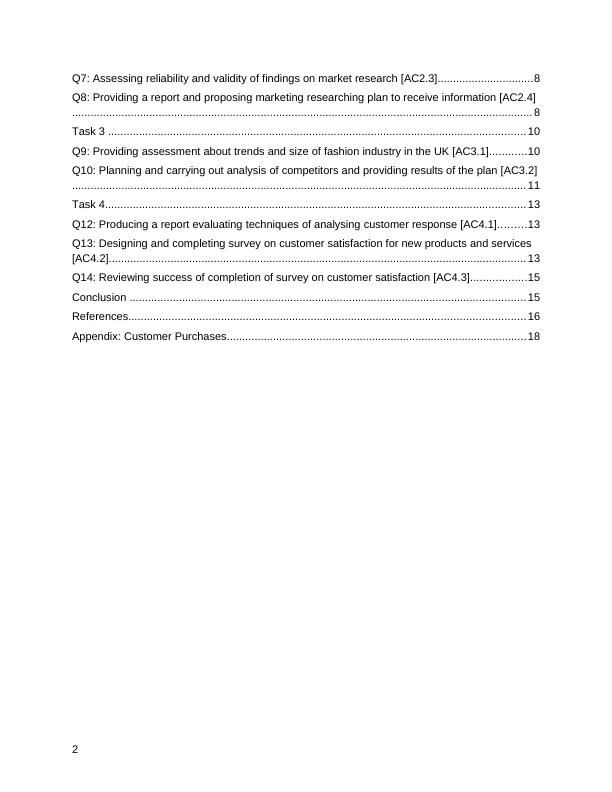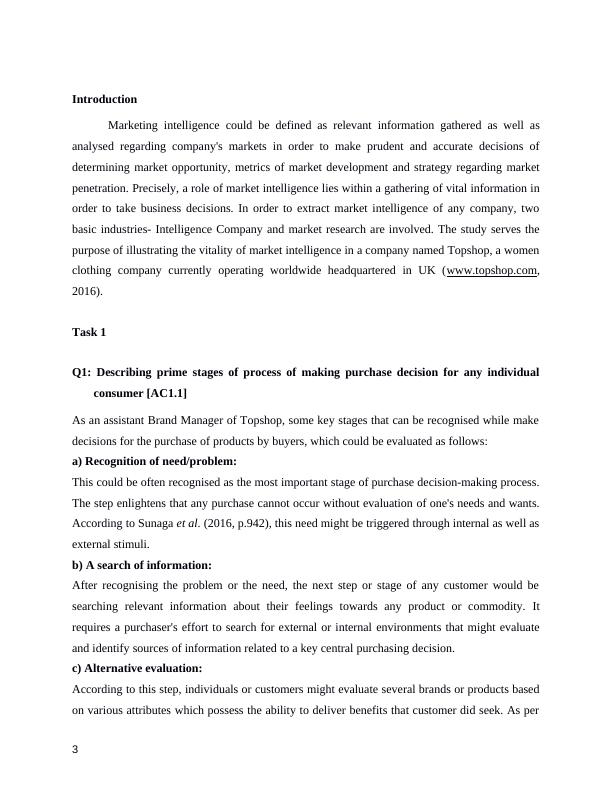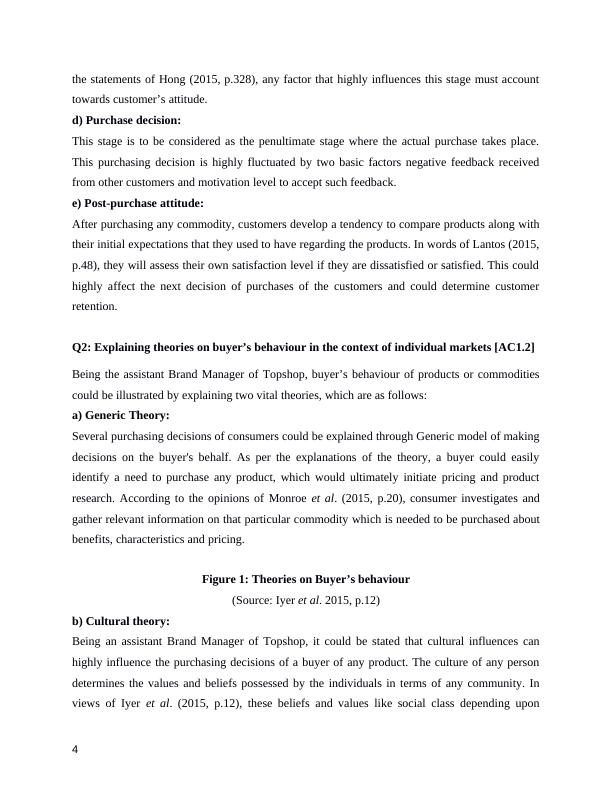UNIT 17 Marketing Intelligence : Assignment
Added on 2020-06-06
19 Pages6101 Words102 Views
UNIT 17. MARKETING INTELLIGENCE Table of ContentsIntroduction .................................................................................................................................3Task 1 .........................................................................................................................................3Q1: Describing prime stages of process of making purchase decision for any individual consumer [AC1.1]........................................................................................................................3Q2: Explaining theories on buyer’s behaviour in the context of individual markets [AC1.2]..........4Q3: Explaining factors that affect behaviour of buyers [AC1.3]....................................................5Q4: Evaluating relationship among brand loyalty, repeat purchase, and corporate image [AC1.4].....................................................................................................................................................5Task 2 .........................................................................................................................................6Q5: Evaluating three kinds of market researching techniques used in market[AC2.1].................6Q6: Identifying and using sources of secondary data in order to pursue objectives of market research [AC2.2]..........................................................................................................................71

Q7: Assessing reliability and validity of findings on market research [AC2.3]...............................8Q8: Providing a report and proposing marketing researching plan to receive information [AC2.4].....................................................................................................................................................8Task 3 .......................................................................................................................................10Q9: Providing assessment about trends and size of fashion industry in the UK [AC3.1]............10Q10: Planning and carrying out analysis of competitors and providing results of the plan [AC3.2]...................................................................................................................................................11Task 4........................................................................................................................................13Q12: Producing a report evaluating techniques of analysing customer response [AC4.1].........13Q13: Designing and completing survey on customer satisfaction for new products and services [AC4.2].......................................................................................................................................13Q14: Reviewing success of completion of survey on customer satisfaction [AC4.3]..................15Conclusion ................................................................................................................................15References................................................................................................................................16Appendix: Customer Purchases.................................................................................................182

Introduction Marketing intelligence could be defined as relevant information gathered as well asanalysed regarding company's markets in order to make prudent and accurate decisions ofdetermining market opportunity, metrics of market development and strategy regarding marketpenetration. Precisely, a role of market intelligence lies within a gathering of vital information inorder to take business decisions. In order to extract market intelligence of any company, twobasic industries- Intelligence Company and market research are involved. The study serves thepurpose of illustrating the vitality of market intelligence in a company named Topshop, a womenclothing company currently operating worldwide headquartered in UK (www.topshop.com,2016). Task 1 Q1: Describing prime stages of process of making purchase decision for any individualconsumer [AC1.1]As an assistant Brand Manager of Topshop, some key stages that can be recognised while makedecisions for the purchase of products by buyers, which could be evaluated as follows:a) Recognition of need/problem:This could be often recognised as the most important stage of purchase decision-making process.The step enlightens that any purchase cannot occur without evaluation of one's needs and wants.According to Sunaga et al. (2016, p.942), this need might be triggered through internal as well asexternal stimuli.b) A search of information:After recognising the problem or the need, the next step or stage of any customer would besearching relevant information about their feelings towards any product or commodity. Itrequires a purchaser's effort to search for external or internal environments that might evaluateand identify sources of information related to a key central purchasing decision.c) Alternative evaluation:According to this step, individuals or customers might evaluate several brands or products basedon various attributes which possess the ability to deliver benefits that customer did seek. As per3

the statements of Hong (2015, p.328), any factor that highly influences this stage must accounttowards customer’s attitude. d) Purchase decision:This stage is to be considered as the penultimate stage where the actual purchase takes place.This purchasing decision is highly fluctuated by two basic factors negative feedback receivedfrom other customers and motivation level to accept such feedback. e) Post-purchase attitude:After purchasing any commodity, customers develop a tendency to compare products along withtheir initial expectations that they used to have regarding the products. In words of Lantos (2015,p.48), they will assess their own satisfaction level if they are dissatisfied or satisfied. This couldhighly affect the next decision of purchases of the customers and could determine customerretention. Q2: Explaining theories on buyer’s behaviour in the context of individual markets [AC1.2]Being the assistant Brand Manager of Topshop, buyer’s behaviour of products or commoditiescould be illustrated by explaining two vital theories, which are as follows:a) Generic Theory:Several purchasing decisions of consumers could be explained through Generic model of makingdecisions on the buyer's behalf. As per the explanations of the theory, a buyer could easilyidentify a need to purchase any product, which would ultimately initiate pricing and productresearch. According to the opinions of Monroe et al. (2015, p.20), consumer investigates andgather relevant information on that particular commodity which is needed to be purchased aboutbenefits, characteristics and pricing. Figure 1: Theories on Buyer’s behaviour(Source: Iyer et al. 2015, p.12)b) Cultural theory:Being an assistant Brand Manager of Topshop, it could be stated that cultural influences canhighly influence the purchasing decisions of a buyer of any product. The culture of any persondetermines the values and beliefs possessed by the individuals in terms of any community. Inviews of Iyer et al. (2015, p.12), these beliefs and values like social class depending upon4

End of preview
Want to access all the pages? Upload your documents or become a member.
Related Documents
Marketing Intelligence Assignment Samples (Doc)lg...
|20
|4332
|37
MARKETING INTRODUCTION TABLE OF CONTENT INTRODUCTION 3 1.1: Main Stages of Purchase Decision Makinglg...
|19
|6105
|386
Marketing Intelligence Assignment- Doclg...
|16
|5101
|146
Study on Marketing Intelligencelg...
|22
|6268
|175
Unit 17 Marketing Intelligence : Case Study on Topshoplg...
|18
|4536
|31
Marketing Intelligence in Topshop : Assignmentlg...
|18
|4021
|53
